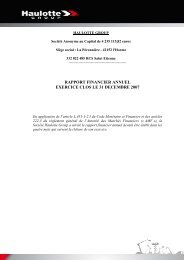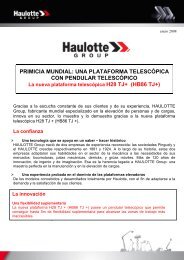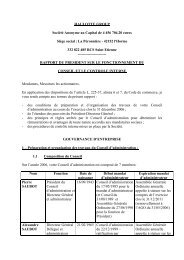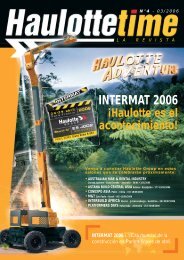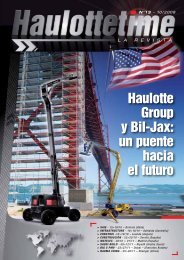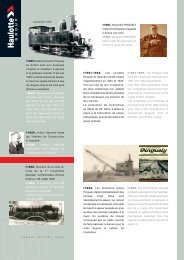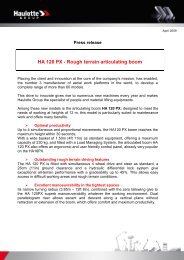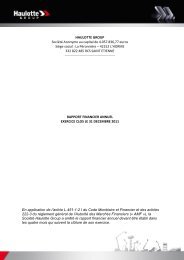2007 - Pinguely Haulotte
2007 - Pinguely Haulotte
2007 - Pinguely Haulotte
Create successful ePaper yourself
Turn your PDF publications into a flip-book with our unique Google optimized e-Paper software.
<strong>2007</strong><br />
annual report # p93-94<br />
Consolidated financial statements of December 31st, <strong>2007</strong><br />
3.13 Stock option plans<br />
The Group has implemented an<br />
equity-settled share-based payment<br />
compensation plan.<br />
Stock options are granted to company<br />
employees. These options are measured<br />
at the grant date using the Black and<br />
Scholes option pricing model. The main<br />
assumptions of this method are<br />
presented in note 23.<br />
The fair value of options is recognized in<br />
the income statement in personnel costs<br />
on a straight-line basis over the period<br />
from the grant date to the vesting date<br />
with offsetting adjustment recognised<br />
directly in equity.<br />
In compliance with the standard’s<br />
transition provisions, this treatment<br />
concerns only plans granted after 7<br />
November 2002 for which rights were<br />
not vested on January 1st, 2005.<br />
3.14 Assets and liabilities of disposal<br />
group<br />
IFRS 5 requires specific classification criteria<br />
for disposal groups held for sale. A disposal<br />
group is a group of current and noncurrent<br />
assets with liabilities directly<br />
associated with those assets that will be<br />
transferred in a single transaction. This<br />
disposal group is considered as held for<br />
sale (classified accordingly at the end of<br />
the fiscal year) when the following criteria<br />
are met:<br />
- It is available for immediate sale in its<br />
present condition;<br />
- The disposal is highly probable.<br />
Assets of the disposal group that meet<br />
criteria for classification as held for sale<br />
shall be measured at the lower of carrying<br />
amount and fair value less costs to sell.<br />
Items that meet such criteria shall be<br />
presented separately in the balance sheet<br />
under current assets and liabilities.<br />
Note 4<br />
Management of financial risk<br />
a) Foreign exchange risks<br />
A significant portion of <strong>Haulotte</strong> Group<br />
sales are in currencies other than the euro<br />
including notably the US dollar and the<br />
British pound sterling. Because sales of<br />
Group subsidiaries are primarily in their<br />
functional currency, transactions do not<br />
generate foreign exchange risks at their<br />
level.<br />
The primary source of foreign exchange<br />
risks for the <strong>Haulotte</strong> Group consequently<br />
results from intercompany invoicing flows<br />
when Group companies purchase<br />
products or services in a currency not<br />
their functional currency (exports of<br />
manufacturing subsidiaries located in<br />
the euro area and exporting in the local<br />
currency of a sale subsidiary).<br />
Such exposures are managed by<br />
<strong>Haulotte</strong> Group SA. For the main<br />
currencies, foreign exchange trading<br />
positions in the balance sheet are partially<br />
hedged using basic financial instruments<br />
(forward exchange sales and purchases<br />
against the euro).<br />
b) Interest rate risks<br />
The Group favours floating-rate debt<br />
which provides it greater flexibility. To<br />
hedge against interest rate risks, the Group<br />
seeks to take advantage of market<br />
opportunities according to interest rate<br />
trends. There is no recourse to systematic<br />
interest rate hedging.<br />
To cover market risks (interest rate and<br />
foreign exchange exposures), <strong>Haulotte</strong><br />
Group has recourse to financial<br />
instrument derivatives. These derivatives<br />
are destined to cover the fair value of<br />
assets or liabilities (fair value hedges) or<br />
future cash flows (cash flow hedges).<br />
However, because financial instruments<br />
held by <strong>Haulotte</strong> Group do not fully<br />
comply with the criteria for hedge<br />
accounting, changes in fair value are<br />
recorded in income statement.<br />
In compliance with the provisions of IAS<br />
32 and 39, derivatives are recorded at fair<br />
value. The fair value of assets and liabilities<br />
traded on an active market is determined<br />
on the basis of the market price at the<br />
closing date for publicly traded<br />
instruments.<br />
c) Credit risk<br />
Credit risk results primarily from exposure<br />
to customer credit and notably<br />
outstanding trade receivables and<br />
transactions.<br />
To limit this risk, the Group has<br />
implemented rating procedures (internal<br />
or independent) to evaluate credit risk<br />
for new and existing customers on the<br />
basis of their financial situation, payment<br />
history and any other relevant information.<br />
Credit risk is also limited by <strong>Haulotte</strong><br />
Group's ability in the event of default by<br />
one of its customers to repossess the good<br />
representing the receivable. Provisions for<br />
collection losses are measured according<br />
to this policy (note 3.7).<br />
d) Liquidity risk<br />
<strong>Haulotte</strong> Group cash management is<br />
centralized. The corporate team manages<br />
current and forecasted financing needs<br />
for the parent company and subsidiaries.<br />
All cash surpluses are invested by the<br />
parent company at market conditions<br />
in money market funds and term<br />
deposits without risk to the capital.<br />
Since 2005, the Group has had a 7-year<br />
€360 million syndicated facility divided<br />
into four tranches for the refinancing of<br />
existing debt, the financing of capital<br />
expenditures, the financing of acquisitions<br />
and working capital requirements. At 31<br />
December <strong>2007</strong>, €79 million of this credit<br />
line have been used.




